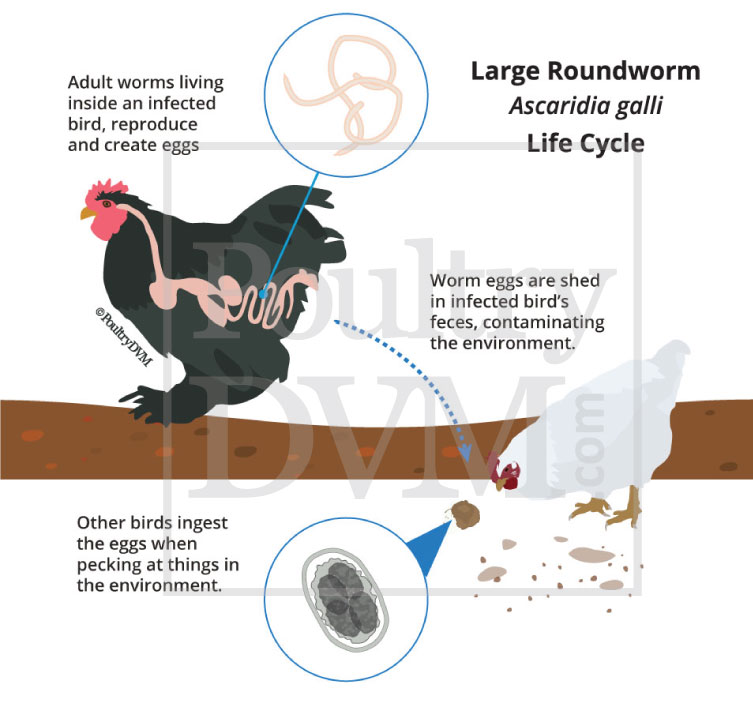Veterinary advice should be sought from your local veterinarian before applying any treatment or vaccine. Not sure who to use? Look up veterinarians who specialize in poultry using our directory listing. Find me a Vet
Other Names: Ascaridiosis, Ascarid Infection

| Name | Summary | |
|---|---|---|
| Albendazole (Valbazen) | 5 mg/kg BW PO single dose | Speer |
| (Fenbendazole) Safe-guard AquaSol for Chickens | Added to the drinking water at a daily dose of 1 mg/kg BW (0.454 mg/lb) for 5 consecutive days. Each mL of Safe-Guard AquaSol contains 200 mg of fenbendazole | Per Manufacturer instructions. |
| (Fenbendazole) Safeguard 10% Liquid Dewormer for Goats | Add to flock's drinking water at a rate of 3 mL per gallon of water for 3 days. Repeat in 10 days | G Damerow |
| (Fenbendazole) Panacur or Safeguard Equine Dewormer 25 g Paste 10% | Given individually to each chicken orally, squeezed out in a pea-size portion and placed inside their mouth. Once a day for 5 consecutive days. Repeat in 10 days. | G Damerow |
| (Ivermectin) 1% Injectable for Cattle and Swine | Given to each chicken orally or added to the flock’s water source. If given by mouth - 0.25 mL per large size, 0.1 mL per bantam size. If added to flock water source- 4 mL per gallon of water. Made fresh daily for two consecutive days. | G Damerow |
| Levamisole | Note- Chickens who are severely debilitated should not be given this medication, because it will impact their ability to fight infections. 1.25-2.5 mg/kg PO q7-14d | Speer |
| Piperazine | Piperazine is no longer available in the United States. It is only effective against the adult large roundworm, not the eggs. It can be given orally by mouth in each bird or added to the flock’s water source. If given by mouth - 50 mg/bird (if younger than 6 weeks of age), otherwise 100 mg/bird (if older than 6 weeks of age), or according to the manufacturer label. Repeat in 7-10 days. If added to flock water source - 3 mL per gallon of water, or in accordance with the manufacturer’s label. Repeat in 7-10 days. | G Damerow |
| Citrus peel ethanolic extract | Given as a feed additive at a rate of 600-1200 mg/kg for 14 days | A Abdelqader et al., 2012 |
| Garlic | 2.5 mg/bird Drinking water - 1.5 mg/L of water daily for 5 days | F Velkers et al., 2011 |
| Turmeric (Curcuma longa) | 200-600 mg/kg | Alrubaie Al, 2015 |
| Papaya (Carica papaya) seed extract | 20 ml/kg feed; 1 mg per chicken for 5 days | Feroza et al., 2017; Dakpogan et al., 2017 |
| Papaya (Carica papaya) seed powder | 6 g/kg body weight; 300 mg/day per bird | Ozaraga et al., 2017; Ameen et al., 2012 |
| Diatomaceous earth | Added as 2% of overall diet | D Bennett; R Isabirye et al., 2019 |
| Pumpkin seeds | 1 g/kg BW | T Feitosa et al., 2013 |

© 2026 PoultryDVM All Rights Reserved.